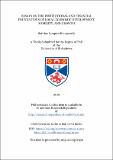Files in this item
Essays on the institutional and financial foundations of local economic development, mobility, and growth
Item metadata
| dc.contributor.advisor | Oto-Peralías, Daniel | |
| dc.contributor.advisor | Chronopoulos, Dimitris | |
| dc.contributor.advisor | Wilson, John O. S. | |
| dc.contributor.author | Kampanelis, Sotirios Lampros | |
| dc.coverage.spatial | 154 p. | en_US |
| dc.date.accessioned | 2019-12-09T15:48:18Z | |
| dc.date.available | 2019-12-09T15:48:18Z | |
| dc.date.issued | 2019-06-28 | |
| dc.identifier.uri | https://hdl.handle.net/10023/19102 | |
| dc.description.abstract | This thesis consists of three independent chapters. Chapter 1 describes briefly several schools of thoughts and recent interest regarding economic development. Moreover, it explains the role of historical shocks on economic development and provides an outline of this thesis. The second chapter examines whether there is any long-term effect arising from ancient colonialism on current economic development along the Mediterranean Sea at the local level. More specifically, it is argued that ancient Greek, Phoenician, or Etruscan colonies that were established after the 8 century BC, left their institutional, technological, and cultural legacy perennially. Therefore, in places where there is at least one ancient colony from the abovementioned civilizations, there is higher development at the beginning of the 21st century. The main variables consist of the coordinates of ancient colonies as well as light density at night from the space as an index of development at the local level. The findings suggest that, indeed, in places that we observe at least one Greek, Phoenician and/or Etruscan ancient colony there is higher recent economic development. Several robustness checks validate the initial hypothesis. In the third chapter, it is assumed that the Australian localities which were colonised earlier by Europeans after 1788, experienced higher economic development nowadays. Due to the limitation of technology, the size of Australia and the dissimilar relationships between Europeans and Aboriginals along the Australian coasts, cities were established almost in a random way and time. It is suggested that cities follow a dynamic process of development based on several forces such as technology adoption, institutional development etc. Thus, time is a significant parameter in explaining the development of urban cities. Chapter 4 examines the role of financial environment on intergenerational mobility. In 1994, the United States adopted a reform which permitted the interstate banking. As a consequence, banking competition at the local level increased and impacted on the real economy via changes in household incomes, entrepreneurship, innovation and state-level GDP. While prior literature has provided insights as to the interconnections between these banking reforms and banking, household, firm and macroeconomic outcomes, to date there is no evidence regarding the implications of banking sector deregulation for the economic mobility of individuals. In Chapter 4, the results of an extensive empirical analysis suggest that banking reforms affected the local financial environment and influenced the rates of intergenerational mobility for children. | en_US |
| dc.language.iso | en | en_US |
| dc.publisher | University of St Andrews | |
| dc.title | Essays on the institutional and financial foundations of local economic development, mobility, and growth | en_US |
| dc.type | Thesis | en_US |
| dc.contributor.sponsor | University of St Andrews. School of Management | en_US |
| dc.type.qualificationlevel | Doctoral | en_US |
| dc.type.qualificationname | PhD Doctor of Philosophy | en_US |
| dc.publisher.institution | The University of St Andrews | en_US |
| dc.identifier.doi | https://doi.org/10.17630/10023-19102 |
This item appears in the following Collection(s)
Items in the St Andrews Research Repository are protected by copyright, with all rights reserved, unless otherwise indicated.

